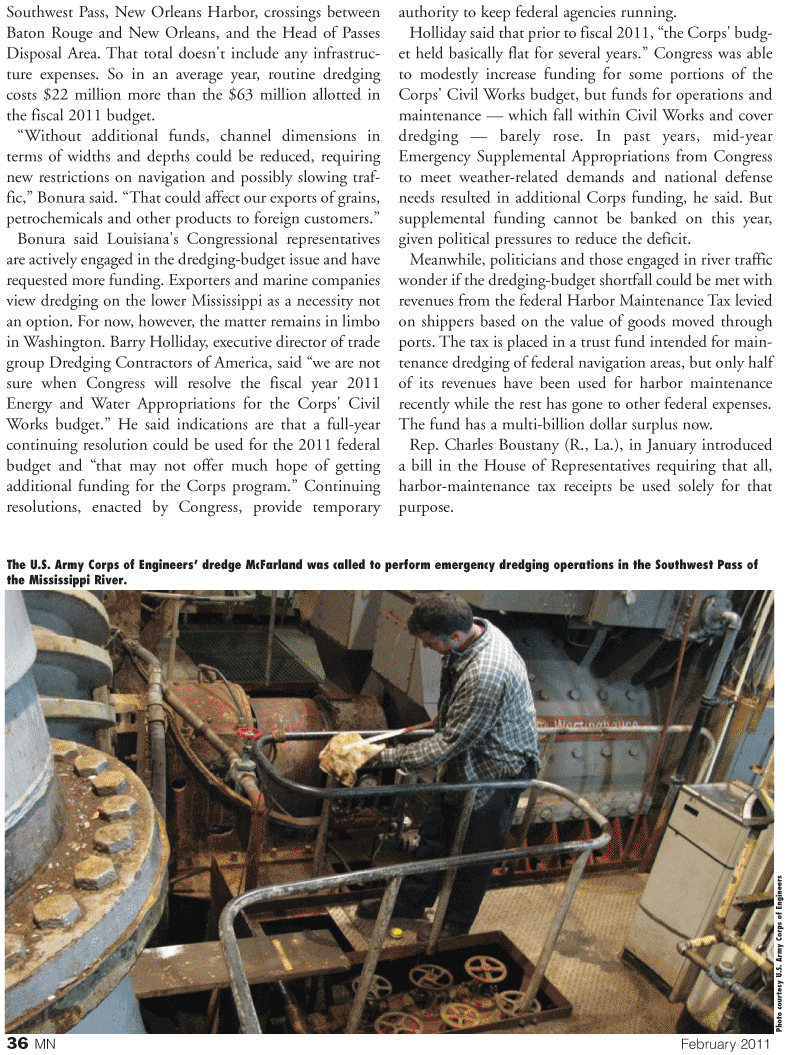
Page 36: of Marine News Magazine (February 2011)
Inland Waterways
Read this page in Pdf, Flash or Html5 edition of February 2011 Marine News Magazine
Southwest Pass, New Orleans Harbor, crossings between
Baton Rouge and New Orleans, and the Head of Passes
Disposal Area. That total doesn't include any infrastruc- ture expenses. So in an average year, routine dredging costs $22 million more than the $63 million allotted in the fiscal 2011 budget. “Without additional funds, channel dimensions in terms of widths and depths could be reduced, requiring new restrictions on navigation and possibly slowing traf- fic,” Bonura said. “That could affect our exports of grains, petrochemicals and other products to foreign customers.”
Bonura said Louisiana's Congressional representatives are actively engaged in the dredging-budget issue and have requested more funding. Exporters and marine companies view dredging on the lower Mississippi as a necessity not an option. For now, however, the matter remains in limbo in Washington. Barry Holliday, executive director of trade group Dredging Contractors of America, said “we are not sure when Congress will resolve the fiscal year 2011
Energy and Water Appropriations for the Corps' Civil
Works budget.” He said indications are that a full-year continuing resolution could be used for the 2011 federal budget and “that may not offer much hope of getting additional funding for the Corps program.” Continuing resolutions, enacted by Congress, provide temporary authority to keep federal agencies running.
Holliday said that prior to fiscal 2011, “the Corps' budg- et held basically flat for several years.” Congress was able to modestly increase funding for some portions of the
Corps' Civil Works budget, but funds for operations and maintenance — which fall within Civil Works and cover dredging — barely rose. In past years, mid-year
Emergency Supplemental Appropriations from Congress to meet weather-related demands and national defense needs resulted in additional Corps funding, he said. But supplemental funding cannot be banked on this year, given political pressures to reduce the deficit.
Meanwhile, politicians and those engaged in river traffic wonder if the dredging-budget shortfall could be met with revenues from the federal Harbor Maintenance Tax levied on shippers based on the value of goods moved through ports. The tax is placed in a trust fund intended for main- tenance dredging of federal navigation areas, but only half of its revenues have been used for harbor maintenance recently while the rest has gone to other federal expenses.
The fund has a multi-billion dollar surplus now.
Rep. Charles Boustany (R., La.), in January introduced a bill in the House of Representatives requiring that all, harbor-maintenance tax receipts be used solely for that purpose.
The U.S. Army Corps of Engineers’ dredge McFarland was called to perform emergency dredging operations in the Southwest Pass of the Mississippi River. 36 MN February 2011
Photo courtesy U.S. Army Corps of Engineers

 35
35

 37
37
